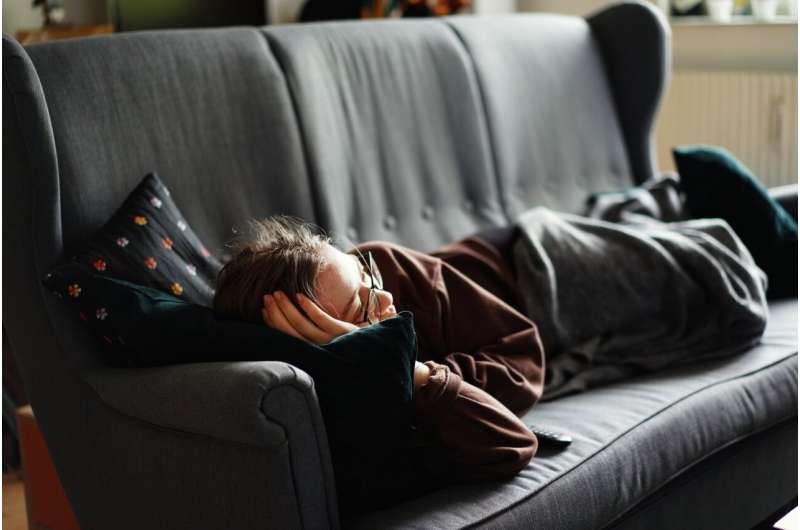This article has been reviewed according to Science X's editorial process and policies. Editors have highlighted the following attributes while ensuring the content's credibility:
fact-checked
trusted source
proofread
Understanding the barriers college students face to healthy leisure activities

College students face different, often co-occurring barriers that may prevent them from participating in healthy leisure activities, like exercising or reading for pleasure, according to new research led by Penn State College of Health and Human Development researchers and alumni.
"Establishing healthy leisure habits in college can contribute to long-term health and well-being, and this research demonstrates the need for universities to actively support student engagement in healthy leisure," said principal investigator Jennifer Agans, assistant professor of recreation, park and tourism management at Penn State.
Agans and her collaborators published their results in the journal Leisure Sciences.
Students may be prevented—or think they are prevented—from participating in healthy leisure because of structural barriers like a lack of money, time or transportation; social barriers like not knowing people to participate in healthy activities with; or personal barriers like a lack of skill in an activity.
To understand which barriers students are facing, the researchers performed a latent profile analysis on survey responses from 605 students at a university in the midwestern United States collected in 2009–10. Latent profile analysis allows researchers to identify previously undetected groups within data. In this case, the researchers modeled which barriers to healthy leisure are likely to co-occur.
Because the researchers who collected the data were interested in the students' perceptions about the barriers they face, the surveys did not define what constituted healthy leisure. Despite the lack of a concrete definition, most respondents identified similar healthy activities—including exercise, reading and spending time with friends—and unhealthy activities—including substance misuse, unhealthy eating and being a "couch potato."
In the analysis, the researchers identified four profiles—or co-occurring groups—of barriers to healthy leisure activities. Since the data were self-reported, the profiles represent barriers perceived by the students. Students in the family/community/resource constraints profile made up 46% of the sample and were most likely to perceive barriers from family suggestions, religion, convenience, affordability and their knowledge level.
Students in the social/comfort/time constraints profile made up 28% of the sample and were most likely to perceive barriers from social circumstances, shyness, time and competing commitments. Students in the few perceived constraints profile made up 18% of the sample and did not believe they faced significant barriers to healthy leisure. Students in the culture/ability constraints profile made up 9% of the sample and were most likely to perceive barriers from disability, skill level and cultural background.
"The profiles that we identified in this analysis should not be regarded as categories that exist everywhere," Agans said. "They are relevant to the university where we collected the data, but they probably differ somewhat from profiles you would find at other schools. The ability to identify profiles, however, is significant. If universities ask their students what barriers to healthy leisure they are facing, the universities will find commonalities among their own students and be better equipped to help their students overcome those barriers."
In 2022, according to the American College Health Association, almost 75% of students across the country reported experiencing moderate to severe psychological distress, over 50% experienced loneliness and only 40% met national recommendations for physical activity. For many students, the removal or reduction of barriers could help them develop healthier habits and alleviate some of the emotional anguish, according to Agans.
"Different people face different barriers to healthy leisure, and some of these break down along demographic lines," Agans said. "People with disabilities may not be able to easily access facilities where leisure activities occur, and women may have safety concerns about exercising outside at night. But college students of all backgrounds face barriers to healthy leisure, and they all need to be empowered to participate. Importantly, not all women have similar needs, nor do all people with disabilities."
Agans said people's brains often go straight to demographics like race and gender if diversity is mentioned. She cautioned, however, that the ways that people differ from each other may or may not map onto our assumptions.
Universities will make mistakes if they make assumptions, according to Agans. As an example, she mentioned that a recreation center could offer classes that teach students how to use exercise machines, but religious or cultural mores may prevent some women from participating in a co-ed class. The co-occurrence of barriers—like knowledge of the equipment and religious or cultural modesty—may prevent participation in ways that cannot easily be predicted.
"If we want healthy leisure to be accessible to everyone, we must examine the barriers that groups of people face and understand how those people try to overcome these barriers," Agans said. "But these groups should not be based on things we already know about the students—like the fact that they are second-year students, international students or women. Instead, groups should be based on shared barriers that people face. If we ask people what prevents them from participating in healthy leisure, and we help them overcome those barriers, then we can help them establish healthy habits that could last a lifetime."
More information: Jennifer P. Agans et al, College Students' Healthy Leisure: Latent Profile Analyses of Constraints and Negotiation Strategies, Leisure Sciences (2023). DOI: 10.1080/01490400.2023.2252434
Provided by Pennsylvania State University





















